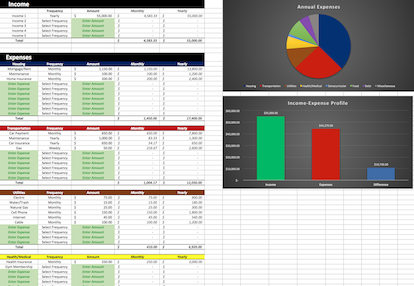
As long-time readers probably know, 401(k)s are, by far, my favorite investment accounts. When it comes to allocating your investment funds, I believe dedicating money to a 401(k) with employer match should take priority over all other options. Most of the people in my life know about my affinity towards 401(k)s (I talk about investing as much as possible, with whoever will listen/discuss 😀 ), and so, armed with this knowledge, a friend of mine recently said to me, "I know you're all about 401(k) investing, but I thought you wanted to retire early? If you put everything into a 401(k) won't you have to wait until you're at least 59.5 before you can get your money?" I decided to write this post in response, to explain exactly how I plan to utilize my retirement accounts in early retirement.
Unlocking Your Accounts
While there are multiple ways to access small portions of your retirement funds before age 59.5 (e.g. to pay health insurance premiums during long periods of unemployment, to help with your first home purchase, to cover college tuition costs, to us as a short-term loan, etc.), the vast majority of your retirement money is typically inaccessible without incurring a heavy 10% penalty. This is a big dilemma for those of us planning to retire, potentially, 15-20 (or more) years before reaching 59.5. In order to retire that early, we need to take advantage of as many investment opportunities as possible to maximize the growth of our money. Passing up on the tax benefits of retirement account investing would severely limit that growth.
So how can you invest in retirement accounts and still have access to your money before traditional retirement age without paying a penalty?
There are two primary options for early retirees, each with its own pros and cons. The first option we'll talk about is called Substantially Equal Periodic Payments or SEPP.
SEPP
The SEPP method utilizes an IRS guideline known as rule 72(t). This rule allows anyone, at any age to withdraw funds from their retirement account (IRA, 401(k), 403(b), 457 plan, etc.), penalty-free, as long as they adhere to a specific set of rules. It works as follows:
Step #1
Select one of your retirement plans to begin making withdrawals from (Note: You must not be currently employed by the employer who sponsored the retirement plan).
Step #2
Decide which of the three IRS-approved methods you want to use to calculate your periodic payments.
Step #3
Once you’ve calculated your payment amount, begin making withdrawals from your chosen retirement account. You can do this with one withdrawal or multiple equal withdrawals, as long as the total amount withdrawn for the year is correct. You must make at least one withdrawal each year.
Step #4
Each year when filing your taxes, submit IRS Form 5329 to show that the retirement distributions you received during the year were exempt from the 10% penalty rule (you will still have to pay normal income taxes on the amount you withdraw each year).
Step #5
Continue to withdraw the same amount of money each year for at least 5 years or until you reach age 59.5, whichever is longer.
Generally speaking, when implemented correctly, the SEPP method can be a very effective way of accessing your retirement funds early. If you choose this method, make sure to speak with a tax/financial professional before you begin. The consequences of making a mistake can be extremely costly and there are several disadvantages to using the SEPP method as well. For example,
- It limits your ability to adapt your investing/withdrawal strategies as the market changes over time
- It forces you to withdraw a specific amount each period whether you want/need to or not
- You must continue receiving payments for potentially very long periods of time depending on your age (whichever is longer, 5 years, or until you reach age 59.5)
- If you stop receiving payments or make a mistake with the amount you withdraw, you could be forced to pay a 10% penalty on all previously received money
- Once you start receiving payments you are not allowed to initiate any other transactions (deposits or withdrawals) in the account
For these reasons and others, I don’t personally plan to utilize the SEPP method in early retirement. There is another option, however, and it’s called a Roth Conversion Ladder.
Roth Conversion Ladder
The key to this option (and the source of its name) can be traced to the unique rules of Roth IRAs. Though just like other retirement accounts, Roth IRAs do not allow the withdrawal of investment gains before the age of 59.5, they are unique in that you can withdraw investment contributions, at any age, penalty-free. This means that the money you contribute to your Roth IRA can be withdrawn at any time as long as you don’t touch the gains.
But how does this fact help us access the funds in our other retirement accounts?
I’m glad you asked! You see when funds saved in a traditional IRA are converted to a Roth IRA, the IRS considers this a contribution. This includes both the contributions and gains in your traditional IRA account!
It’s not quite that simple though, there are a few obstacles to navigate as well.
When you convert funds from a traditional IRA to a Roth IRA, you are not allowed to immediately begin using the money. Instead, you are required to let the funds sit in the Roth account for 5 years before making any withdrawals, otherwise, you’ll face the 10% penalty. In addition, the money you convert is treated as normal income, meaning it will be taxed at your income tax rate the year you make the conversion.
These factors do limit this strategy to some degree but it can still be very effective (and there are ways to constrain the impact of these disadvantages that I'll expand upon in this article).
Create Your Ladder
Here's how a Roth Conversion Ladder works:
Step #1
If you don’t already have a good idea of what your total yearly expenses are, spend some time figuring that out. This will help determine how much you need to convert each year. Using an online budget tracking tool like Personal Capital can help with this.
Step #2
Leave your job and join the growing ranks of early retirees.
Step #3
Rollover any employer-sponsored retirement plans you hold (401(k), 403(b), 457, etc.) into a traditional IRA. This transaction should be both penalty and tax-free.
Step #4
Convert the amount you determined in Step #1 from your traditional IRA to a Roth IRA (you will owe income taxes on the amount you convert).
Step #5
Repeat the steps above each year until you reach age 54 (5 years from age 54 you’ll no longer face any penalty for accessing your retirement accounts, so you don’t need to initiate any additional conversions).
Step #6
Following the initial 5-year waiting period, you can begin withdrawing the amount you converted 5 years previous (e.g. money converted in 2018 can be withdrawn in 2023, money converted in 2019 can be withdrawn in 2024, etc.).
I know this process may seem a little confusing so let’s do an example to clear things up.
Example
Lois has just hit her retirement number (the amount of money she needs to retire)! She is ready to jump out of corporate America and spend some time traveling and pursuing her passions. She has some money saved in a taxable investment account but the vast majority of her savings are in a 401(k). She decides to employ the Roth Conversion Ladder method.
Lois' Info:
Age = 45
Total Yearly Expenses = $35,000
Retirement Number = $875,000 (i.e. $35,000 x 25)
Taxable Investment Account Balance = $175,000
401(k) balance = $700,000
Lois resigns from her job and rolls the balance of her 401(k) into a traditional IRA. She then begins a Roth Conversion Ladder. See the table below for the breakdown.
Year Age Traditional To Roth IRA
Conversion AmountSpending Money Source Of Spending
Money
2018 45 $35,000 $35,000 Taxable Account
2019 46 $35,000 $35,000 Taxable Account
2020 47 $35,000 $35,000 Taxable Account
2021 48 $35,000 $35,000 Taxable Account
2022 49 $35,000 $35,000 Taxable Account
2023 50 $35,000 $35,000 2018 Conversion
2024 51 $35,000 $35,000 2019 Conversion
2025 52 $35,000 $35,000 2020 Conversion
2026 53 $35,000 $35,000 2021 Conversion
2027 54 $35,000 $35,000 2022 Conversion
2028 55 $0 $35,000 2023 Conversion
2029 56 $0 $35,000 2024 Conversion
2030 57 $0 $35,000 2025 Conversion
2031 58 $0 $35,000 2026 Conversion
2032 59 $0 $35,000 2027 Conversion
... 60+ $0 $35,000 *Direct Withdrawal
From Any Of Your
Retirement Accounts
*Remember, after age 59.5 you no longer face any penalties for withdrawals.
The 5 Year Problem
So…I won’t gloss over it. There is an obvious flaw with the Roth Conversion Ladder. The fact that you must wait 5 years to make your first withdrawal may make this method impossible for some. If the vast majority of your savings is held in a 401(k) or traditional IRA, it could be very difficult to survive for 5 years without a steady income. While there’s no simple solution to this problem, there are a few options:
- Always allocate some portion of your investment funds to a taxable investment account. Be sure to have enough for 5 years of expenses before leaving your job.
- After saving enough to retire early in your retirement investment account(s), work a bit longer to build up your non-retirement account savings/investments.
- Prioritize contributions to your Roth IRA account over other retirement accounts. Remember, direct contributions (i.e. non-conversions) can be withdrawn without a waiting period (I'm clearly not a fan of this option).
- Work a part-time job to supplement your income while you wait for the funds in your Roth Conversion Ladder to mature.
- Use the SEPP method until your converted funds can be withdrawn (you’d still be required to follow all of the requirements of the SEPP method discussed above).
- Move to an area with a lower cost of living so you don't need as much money to maintain your lifestyle.
- Sell some of your stuff (clothes, cars, real estate, property, etc.) to generate revenue and cut costs.
Final Thoughts
Most people I’ve spoken with believe their retirement savings is out of reach until they reach traditional retirement age. Some have even chosen to forgo investing in a retirement account all together because of this. This is a huge mistake. The advantages of retirement account investing should not be taken for granted. Whether you're shooting for early retirement or not, you should never pass up the opportunity to increase your gains by investing in a tax-advantaged retirement account. Now that you've learned how to unlock access to your accounts early, there's no excuse for not investing!
Tools To Get You Started
Get a head start on your journey toward achieving financial independence by analyzing and tracking your income, expenses, investment performance, and overall net worth with the free online wealth management tool Personal Capital.
We use Personal Capital regularly to analyze our investment fees, track our investments, and project our net worth. We also periodically review our progress toward retirement with their retirement planning calculator.
If you’d rather do things on your own, become a subscriber today and you’ll receive our Free Financial Planning Dashboard. This tool allows you to enter your income and expenses to create a detailed budget. You can use it to track your spending habits over time or just to get an idea of where your money is going each month. Take a look at the automatically generated charts and you may discover you have a little more cash to invest than you thought.
If you’re interested in detailed instructions on how to budget, save, pay off debt, and invest, check out The 6 Phases of Building Wealth. This book provides step-by-step instructions for working through each “Phase” in the process of achieving Financial Freedom. If you're just starting out, the information in this book will provide you with an invaluable resource. You can pick up the digital version for only $2.99 on Amazon.
Disclosure: Some of the links found on this website may be affiliate links. Affiliate links pay GGD a small commission when you click through and/or make a purchase. This is at zero additional cost to you.
Full Disclaimer/Disclosure
Related Posts
-
Why 401(k)s Are The Best Investments, Period
There are plenty of great investment options out there to choose from, but very few can compete with the advantages of a 401(k). When you add in employer matching to the equation, I believe 401(k)s…
-
Investment Hierarchy: Top 7 Investments For Retiring Young
When you make the decision to become an early retiree, one of the first things you'll realize is that there are many, many different choices when it comes to investment accounts. 401(k), IRA, HSA, 457,…
-
The Simple Formula I’m Using To Retire In My 30's
Wake up, go to work, spend a few hours with family, go to bed, rinse and repeat. Some form of this routine probably describes the typical day for most of us. Throughout our lives, we’re…







Really good read! Broke it down very well!
Thanks Geoff, glad I could help. Are you leaning toward SEPP or Roth Conversion Ladder?
Nice! Do the rollover conversions create any mingling issues with the existing Roth money? I have a considerable amount in my current Roth, and don’t want to mess than up with money that has a 5 year limitation, thereby making the whole nut subject to a 5 year limitation. Thanks!
Luckily the IRS adheres to strict ordering rules for distributions (see: https://www.irs.gov/publications/p590b#en_US_2017_publink1000231071). When you make a withdrawal form your Roth IRA they classify the money in the following order:
1st – Regular contributions
2nd – Taxable conversions
3rd – Non-Taxable conversions
4th – Earnings on contributions.
As a result, there shouldn’t be any mingling issues. Hope this helps!